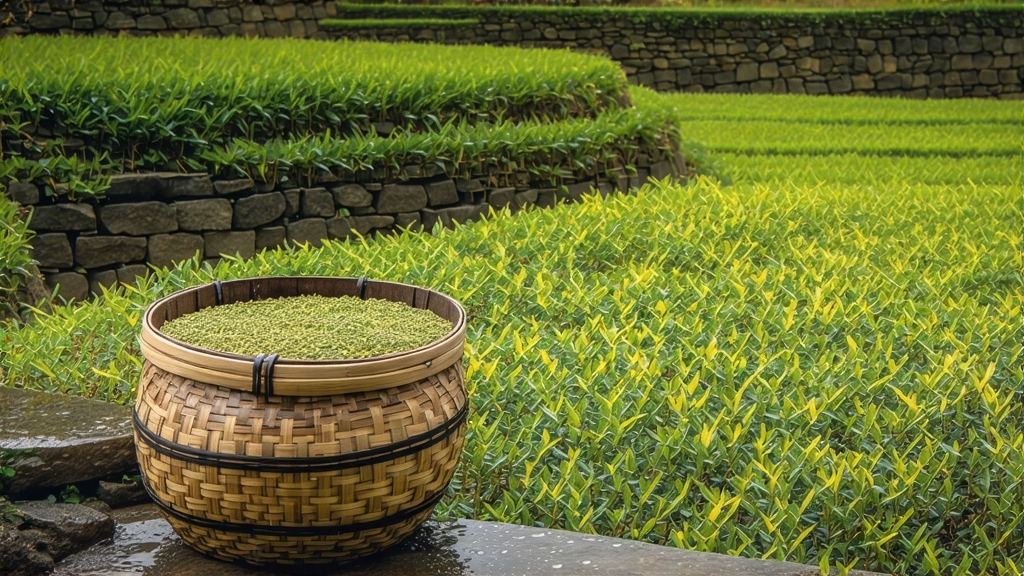
Tucked high on the northern rim of the Sichuan Basin, where the Min River carves clouds into the shoulders of Mengding Mountain, a tea once commanded the same reverence from Tang-dynasty emperors that Laotian wild tea now receives from third-wave baristas. Yet outside a small circle of growers and aging scholars, Meng Ding Huang Ya—literally “Yellow Bud from Meng Peak”—remains a whisper even inside China, let alone on the global stage. This essay invites the international reader to listen to that whisper until it becomes a song of altitude, alchemy, and amber liquor.
-
A summit older than Chinese tea itself
Mengding’s tea legend begins in 53 BCE when the Daoist cultivar-monk Wu Lizhen planted seven tea bushes on the summit, an act still commemorated by a stone alter and protected “ancestral” plants. By the Tang (618-907 CE) the buds were freighted down the Min and Yangtze to Chang’an, sealed with yellow silk because yellow was the imperial color. The Song “Cha Jing” already lists “Meng Huang” as one of five tribute teas; Ming tax records show 560 kilograms levied annually; Qing emperors doubled that quota. When the empire collapsed in 1911 the tribute system vanished, and with it the know-how of yellowing the leaf. Only in 1959 did a Sichuan agricultural team rediscover the protocol in an old monastery diary, restarting production for state banquets. Thus every sip today is a re-enactment of 1,300 years of courtly protocol. -
What makes a bud “yellow”
Western drinkers often meet yellow tea through the lens of green: “It’s like green but smoother.” The simplification is forgivable yet misleading. Green tea kills green enzymes with immediate high heat; yellow tea invites those enzymes to a second, gentler dance. After the initial fixation (shaqing) the leaf is still physiologically active; by wrapping it in thick paper or steamed cloth for 4–8 hours at 28–32 °C and 75 % humidity, the farmer encourages non-enzymatic oxidation, amino acid conversion, and a slight Maillard browning. The result is a muted jade-yellow leaf, a liquor the color of chardonnay, and a fragrance that oscillates between fresh chestnut and steamed rice. -
Micro-terroir above the clouds
Mengding’s gardens sit between 800 m and 1,450 m, a band where Sichuan’s humid basin air collides with Tibetan Plateau chill. Annual mean temperature is 14.5 °C; on 220 days the mountain is wrapped in fog that filters UV into a soft, photosynthetic lantern. The soil is a porphyritic sandy loam, rich in potassium and selenium leached from granite parent rock. Such conditions slow budding: the spring harvest window is barely 15 days, usually 20 March–5 April, yielding only the terminal bud and half-unfolded first leaf (standard: 1.5–2.0 cm length, 0.8 g/100 buds). A skilled plucker gathers 600 grams fresh weight per hour; 4.2 kg of buds become 1 kg of finished tea. -
Crafting the bud: a six-act play
Act I: Picking at dawn when leaf temperature is below 12 °C to lock in floral volatiles.
Act II: Withering on bamboo trays for 2 h in mountain shade; moisture drops from 76 % to 68 %.
Act III: Fixation in a 120 °C drum for 3 min; polyphenol oxidase is 95 % denatured, yet some residual activity survives.
Act IV: The yellowing—wrapped in three layers of yellow kraft paper, stacked in cedar boxes, rested 6 h; the leaf temperature self-elevates to 38 °C, then cools in cycles.
Act V: Re-firing at 80 °C to 10 % moisture; the master judges by ear—leaves crackle like thin ice.
Act VI: Sorting by hand under north skylight; only buds that show a “golden tip” (a tiny yellow down) pass as Grade I. From plucking to tin takes 24 hours of continuous labor. -
Grades and market morphology
Meng Ding Huang Ya is sold in three grades